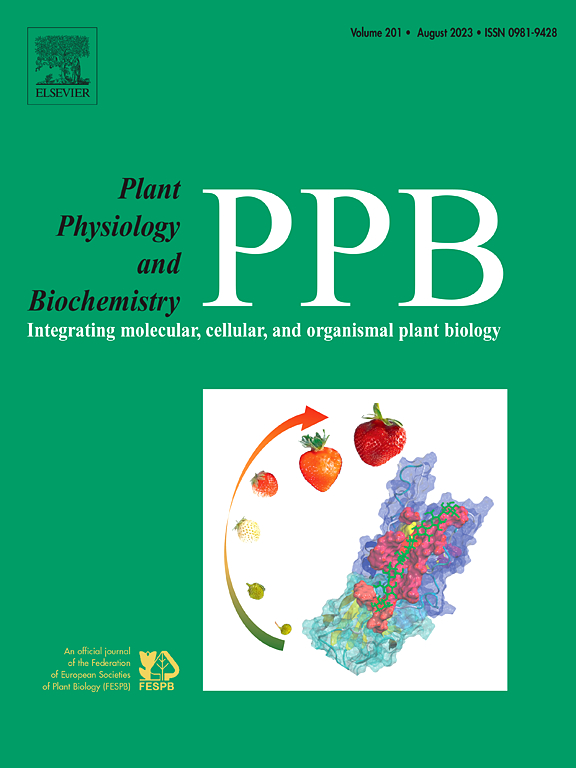Arbuscular mycorrhizal fungi confer aluminum toxicity tolerance in Ricinus communis via modulating root metabolic mechanisms and the composition and quantity of root exudates
IF 6.1
2区 生物学
Q1 PLANT SCIENCES
引用次数: 0
Abstract
Aluminum (Al) phytotoxicity is an essential factor that severely threatens plant productivity in acidic soil with pH < 5. Nevertheless, the specific interactions and functional contributions of arbuscular mycorrhizal fungus (AMF) in the adaptability of Ricinus communis to Al stress remain poorly understood. In this study, we investigated the changes in biomass, Al accumulation, antioxidant system, sucrose metabolism, gene expression, and root exudates of R. communis when regulated by AMF (Rhizophagus intraradices, Funneliformis mosseae, and Diversispora versiformis) under Al stress (0–1.2 g kg−1). Al detoxification by AMF - R. communis symbiosis was manifested by activating antioxidant levels, sucrose metabolism, thereby alleviating lipid peroxidation (MDA decreased 11.44 %–24.89 %) and increasing plant biomass (10.34 %–33.33 %). Meanwhile, transcriptome analysis revealed 659 differentially expressing genes (DEGs) in AMF-inoculated plants in comparison to non-inoculated plants subjected to Al stress. Furthermore, AMF colonization induced 929 differential metabolites (DAMs) from the perspective of root exudates. The integrating analysis of gene expression and root exudate changes indicating that AMF colonization under Al stress was closely related to ABC transporters, glutathione metabolism, nitrogen metabolism, cyanoamino acid metabolism, starch and sucrose metabolism. Altogether, the result of this study suggest that AMF confer Al tolerance to R. communis via antioxidant activation, sucrose metabolism regulation, and reshaping root exudates and gene networks. The present study provides new insights into the crucial role of AMF in improving Al-tolerance of R. communis.
丛枝菌根真菌通过调节根代谢机制和根分泌物的组成和数量赋予蓖麻的铝毒性
铝(Al)植物毒性是酸性土壤中严重威胁植物生产力的重要因素。5. 然而,丛枝菌根真菌(AMF)在蓖麻(Ricinus communis)对铝胁迫的适应性中的具体相互作用和功能贡献仍然知之甚少。本研究研究了在铝胁迫(0 ~ 1.2 g kg−1)下,由AMF(根食菌根内、mosseae和versispora versiformis)调控的芦笋(R. communis)生物量、铝积累、抗氧化系统、蔗糖代谢、基因表达和根分泌物的变化。AMF - R. communis共生解毒表现为激活抗氧化水平和蔗糖代谢,从而减轻脂质过氧化(MDA降低11.44% ~ 24.89%),增加植物生物量(10.34% ~ 33.33%)。同时,转录组分析显示,与未接种amf的植株相比,接种amf的植株在铝胁迫下存在659个差异表达基因(DEGs)。此外,从根分泌物的角度来看,AMF定殖诱导了929种差异代谢物(dam)。基因表达与根分泌物变化的综合分析表明,铝胁迫下AMF定植与ABC转运蛋白、谷胱甘肽代谢、氮代谢、氰氨基酸代谢、淀粉和蔗糖代谢密切相关。综上所述,本研究结果表明,AMF通过抗氧化激活、蔗糖代谢调节、重塑根分泌物和基因网络,赋予了黄姜对铝的耐受性。本研究为AMF在提高红豆耐铝性中的重要作用提供了新的认识。
本文章由计算机程序翻译,如有差异,请以英文原文为准。
求助全文
约1分钟内获得全文
求助全文
来源期刊
CiteScore
11.10
自引率
3.10%
发文量
410
审稿时长
33 days
期刊介绍:
Plant Physiology and Biochemistry publishes original theoretical, experimental and technical contributions in the various fields of plant physiology (biochemistry, physiology, structure, genetics, plant-microbe interactions, etc.) at diverse levels of integration (molecular, subcellular, cellular, organ, whole plant, environmental). Opinions expressed in the journal are the sole responsibility of the authors and publication does not imply the editors'' agreement.
Manuscripts describing molecular-genetic and/or gene expression data that are not integrated with biochemical analysis and/or actual measurements of plant physiological processes are not suitable for PPB. Also "Omics" studies (transcriptomics, proteomics, metabolomics, etc.) reporting descriptive analysis without an element of functional validation assays, will not be considered. Similarly, applied agronomic or phytochemical studies that generate no new, fundamental insights in plant physiological and/or biochemical processes are not suitable for publication in PPB.
Plant Physiology and Biochemistry publishes several types of articles: Reviews, Papers and Short Papers. Articles for Reviews are either invited by the editor or proposed by the authors for the editor''s prior agreement. Reviews should not exceed 40 typewritten pages and Short Papers no more than approximately 8 typewritten pages. The fundamental character of Plant Physiology and Biochemistry remains that of a journal for original results.

 求助内容:
求助内容: 应助结果提醒方式:
应助结果提醒方式:


